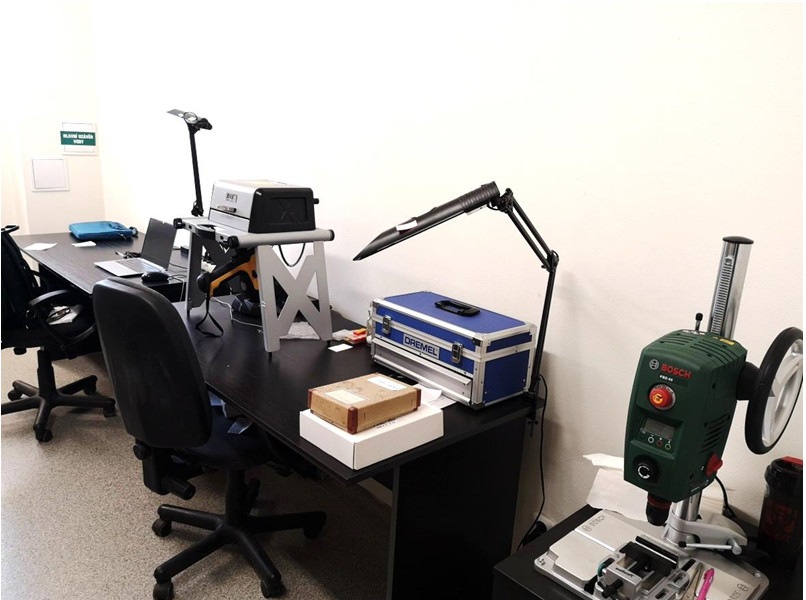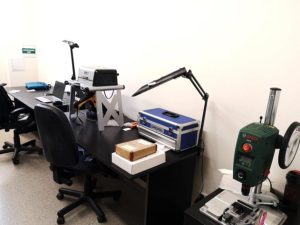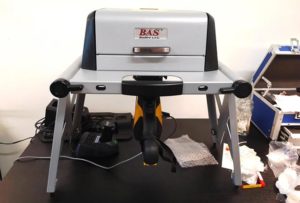
01 Oct X-Ray Fluorescence (XRF)
X-ray fluorescence spectrometry laboratory (XRF lab) has been a part of the Archaeological Centre in Olomouc since September 2018. The lab is currently equipped with an X-ray fluorescence spectrometer (Delta Olympus, MA, USA), two (mobile and table) drills for sampling and a laptop with a software for data analysis.
Our lab is primarily focused on an element analysis of metal artefacts found in archaeological excavations. Apart from metal artefacts, ceramics, glass, organic, and other inorganic materials can be analysed. The construction of the spectrometer enables its transport and therefore, it can be used also for field analyses or for analyses in museums and depositories, if it is not possible for whatever reason to transport the samples to our lab.
The measurement method was adjusted to make it possible to detect, apart from the major components, also minor components and trace elements of the analysed material. A content of these minor components (such as Nickel, Cobalt, Silver, Plumb etc. in a case of alloys) is a key for a detection of the origin of the artefacts and for a determination of the technological processes used in their production. This postulated theory has been recently discussed by experts in the fields of archaeology and chemistry.
Sampling is a crucial step of the analysis. According to the scientific literature, the measurement is distorted and irrelevant, when the surface of the analysed artefact is covered by a patina, which is usually composed of different chemical elements than the intact inner part of the artefact. This kind of data can provide just a basic information about object composition. If it is possible to take a sample of more than ten milligrams from the inner part of the artefact, it is usually possible to determine also a content of trace elements (usually above 100 PPM).
X-ray fluorescence (XRF) is the most often used method of atom spectroscopy and it is usually used for solid samples analysis. Multi-elemental analysis of samples is a big advantage of this method. Mobile X-ray fluorescence is a technique of non-destructive analysis of elemental composition, which enables measurements in a terrain and requires minimal or none sample pre-treatment.
Ionisation of the sample atoms is a basic principle of the method. X-ray spectrometry includes following processes: generating of the primarily radiation in the anode of the X-ray tube, interaction of the radiation with the sample, emission of secondary X-rays and its measurement by a detector.
After the irradiation of the sample, X-ray photon with sufficient energy can expel an electron from one of its inner shells. The originated vacancy is filled by transferring an electron from the outer shell. During this process, the electron from the outer shell loses its energy in a form of the X-ray radiation. The energy of the emitted radiation is specific for each atom and enables its identification. (Artioli, 2010; Beckhof et al., 2006; Pollard et al., 2007).
References:
Artioli, G., 2010. Scientific Methods and Cultural Heritage: An Introduction to the Application of Materials Science to Archaeometry and Conservation Science. Oxford: Oxford University Press.
Beckhoff, B., Kanngießer, B., Langhoff, N., Wedell, R., Wolff, H., 2006: Handbook of Practical X-Ray Fluorescence Analysis. Springer.
Pollard, M., Batt, C., Stern, B., Young, S.M.M., 2007: Analytical Chemistry in Archaeology. United States of America: Cambridge University Press.

XRF laboratory.

X-ray fluorescence spectrometer.

Detail of sampling with a laser aiming at the sampling place.





